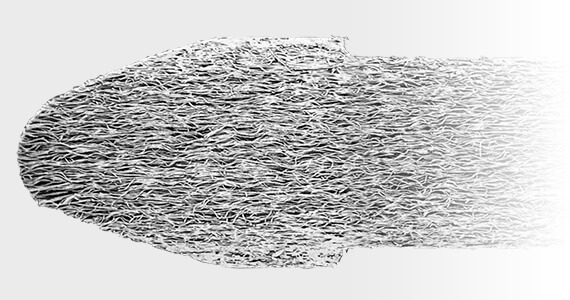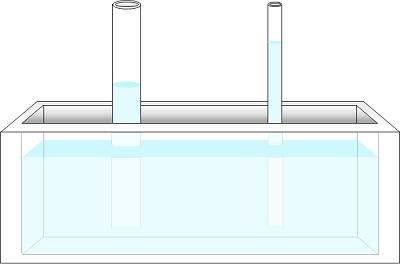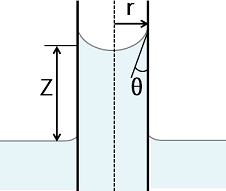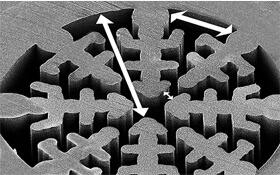Our "capillary force control technology for porous materials" has been fundamental to TEIBOW, a top share company on the industry.

《Porous body》
A porous body generally means an individual with a small space inside.
Since our porous body consists of directional fibers, it is characterized by directional pores as shown in the left figure.
The orientation of the pores plays a role in smooth ink flow from an ink reservoir when assembled to a pen.
《Capillary force》
It's a phenomenon in which a liquid is absorbed into a small space regardless of gravity or vertical and horizontal directions. The force that causes capillary action is called capillary force.
For example, it is a phenomenon that is familiar to us, such as the phenomenon that plants absorb water from the roots, and the phenomenon that when the edge of a towel gets wet, it absorbs up to the top.

We here explain the principle of strength of capillary force.
You can see the glass tubes with different size are set up in the box containing water as shown in the left figure.
The water in the smaller glass tube goes up even higher, as the adhesive force and surface tension of the liquid rises to the point where it balances the gravity of the liquid.
In other words, the narrower the internal space is, the stronger the capillary force becomes.
Although the materials are different, we apply the same theory to our products.
Below is a calculation formula for calculating the strength of capillary force: the height at which the liquid level rises.

=The height of the liquid level rises

θ:Contact angle
T:Surface tension
r : Tube radius
y:Specific gravity of liquid
Capillary force control
Capillary force plays a fundamental and indispensable role in ink absorption, ink retention and ink flowing out.
Our know-how of capillary force control can realize your finer demands.
It is necessary to make the capillary force stronger and weaker depending on your request.
We’re ready to make full use of various combinations to realize all the requirements of yours.
What is possible by controlling capillary force
Here are some typical examples about how capillary force control plays the role in the pen tip.
1.Ink ejection adjustment
For having the more initial ink flow, we need to modify the capillary force, and the result should be close to the black curved line.
For having the longer consumption of ink, the result should be close to the white curved line.
Upon the customer requests, we will modify the capillary force.
2.Ink absorption adjustment
In order to meet a demand for speeding up ink-up time or extending the distance, we design an optimal capillary force starting from the physical properties of the ink.
3.Improvement on a performance of cap-off
A performance of “cap-off” is controllable with a suitable design of capillary force although ink is an important factor for it.
Cap-off
→It's a phenomenon of writing trace being faded that is caused by evaporating solvent in ink components when a pen is left without a cap.
4. Improvement on a performance of drain-back.
We make capillary force stronger to improve a performance of drain-back.
Drain-back
→It's a phenomenon of writing trace being faded or a color of ink being fainted in consequence of that ink contained in an ink reservoir and a nib goes down by gravity when a pen is left upwards.
Here is the explanation about how we control the capillary force of fiber tip and plastic tip, our major products.
How to control the capillary force of fiber tips
By changing diameter of fiber and number of fibers.
《How to control the capillary force of plastic nib》
By changing inner pattern/shape.

Regardless of capillary force by entire inner shape, there are both narrow space and large space.
Each space has the functional effect on the performance of pen nib.
1. Narrow space (=strong capillary force) ⇒deliver and retain the ink
2. Large space (=week capillary force) ⇒flow out the ink
Brushstroke control
A writing feel of a nib is directly linked to a writing comfort of a pen.
Generally, required hardness differs depending on the application of a pen and shape of a nib. For example, an oil-based pen requires durability and a hard writing feel, and a brush pen requires an elastic writing feel enabling to change a line width easily.
The number of customers seeking new brushstrokes has increased in recent years.
Since we have abundant raw materials, we can meet high requirements of yours.